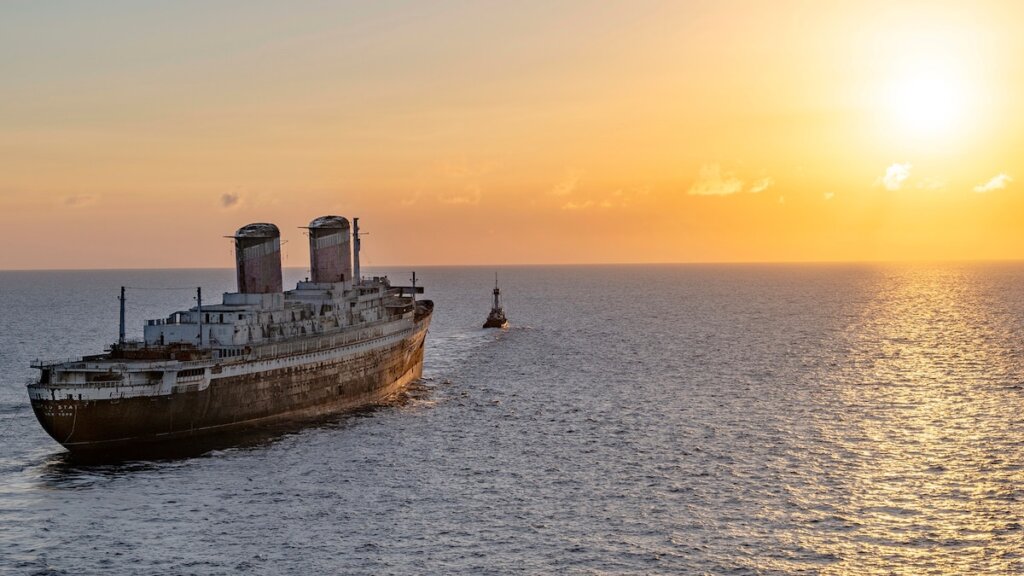Transforming Maritime Legends into Underwater Ecosystems: The Journey of a Veteran Ship Sinker
The Epic Transition of the Iconic Ocean Liner into an Underwater Sanctuary
In the depths beneath the ocean’s surface, a remarkable transformation is underway. The legendary ocean liner, once a symbol of luxury and grandeur, is being reborn as the world’s most expansive artificial reef. This ambitious project is spearheaded by seasoned professionals specializing in ship sinking and reef creation, blending maritime history with ecological innovation.
Behind the Scenes: Preparing a Historic Vessel for Its Final Voyage
Deep within the massive hull of the SS United States, a ship that once hosted luminaries like John F. Kennedy and Elizabeth Taylor, veteran ship-sinker Captain Tim Mullane meticulously prepares for its descent into the sea. Standing inside one of the ship’s colossal fuel tanks, Mullane, a former Navy officer with over five decades of experience, operates a high-powered pressure washer, removing layers of oil and toxic residues. Dressed in protective gear, he exemplifies the meticulous care required to ensure the vessel’s safe transformation into an artificial reef.
This process involves a comprehensive six-month decontamination phase, during which toxic materials are carefully extracted to meet strict environmental standards. The goal is to sink the ship upright, free of hazardous substances, and intact enough to serve as a thriving habitat for marine life. Mullane likens his role to that of a ship’s undertaker, guiding the vessel to its final resting place beneath the waves.
The Evolution of Shipwrecks as Marine Habitats
The practice of converting decommissioned ships into artificial reefs gained momentum in the late 20th century, initially focusing on World War II-era warships. Today, the United States leads in this innovative approach, primarily along its Atlantic and Gulf coasts, where local governments see reefs as a means to boost underwater tourism and bolster local economies. These submerged structures attract divers, fishermen, and marine researchers alike, creating a sustainable cycle of ecological and economic benefits.
In recent years, the focus has expanded to include large-scale projects like the sinking of the SS United States, which is set to become the largest artificial reef globally. The investment reflects a strategic effort to enhance marine biodiversity, combat coastal erosion, and promote eco-tourism. For example, Florida’s Okaloosa County invested over a million dollars to acquire and prepare the ship, recognizing its potential to draw thousands of divers annually.
The Human Element: Expertise and Passion in Reef Creation
Founded in 2014 by Mullane and his wife Coleen O’Malley, Coleen Marine has become a leader in the field of ship sinking for reef development. Mullane’s lifelong fascination with ships-spanning four years in the Navy and subsequent work in shipbreaking-has fueled his dedication to this niche industry. His team’s projects range from creating artificial reefs to coastal protection initiatives, each tailored to the unique characteristics of the vessel and the environment.
The process involves stripping the ship of paint, removing fuel tanks, and extracting insulation and other hazardous materials. Despite the routine nature of these tasks, Mullane emphasizes the emotional connection many feel toward these vessels. “Many of these ships have a storied past, and it’s bittersweet to see them go,” he reflects, acknowledging the sentimental value they hold for former crew and passengers.
The Final Countdown: Sinking the SS United States
Currently docked in Mobile Bay, Alabama, the SS United States is undergoing final preparations. The team has removed over 300 portholes, detached massive propellers, and is in the process of removing the ship’s iconic funnels. The next phase involves a carefully orchestrated sinking operation scheduled for November, which requires precise engineering and coordination.
Marine biologist Alex Fogg, advising Okaloosa County, plays a crucial role in ensuring environmental compliance. His team inspects the vessel to certify that all toxic substances have been eliminated, adhering to federal and state regulations. Once approved, Mullane’s team will fill the ship’s fuel tanks with nearly two million gallons of water, then tow it 150 miles offshore. Using high-powered torches, the crew will create multiple openings along the hull, allowing seawater to flood the interior and initiate the sinking process.
This operation is fraught with risks; uneven flooding or premature sinking could cause the vessel to capsize or sink improperly. Past incidents, such as the partial sinking of the Spiegel Grove in 2002, serve as cautionary tales. To mitigate such risks, engineers develop detailed sinking models to ensure the United States will descend upright and intact.
The Moment of Submersion and the Legacy of a Maritime Icon
As the ship begins its descent, Mullane and his crew will evacuate via a nearby tugboat, with Mullane being the last to leave. The sinking is expected to take less than an hour, after which the SS United States will rest 180 feet below the surface, serving as a vibrant habitat for marine species and a new chapter in its storied history.
Back inside the ship’s tanks, Mullane reflects on the transformation. “You find oil in places you never expected,” he chuckles, climbing out of the tank. Walking through shadowy corridors lined with paint chips, he gazes upward at the two towering funnels. “Some days, I just sit here and marvel at her beauty,” he admits, acknowledging the vessel’s enduring legacy.
Ensuring Environmental Integrity and Future Prospects
Before the sinking, environmental assessments are conducted to ensure compliance with marine protection standards. Marine biologists like Fogg oversee the removal of hazardous materials and certify the vessel’s readiness. Once submerged, the ship will become a thriving artificial reef, supporting diverse marine ecosystems and attracting eco-tourists.
The SS United States project exemplifies the innovative intersection of maritime history, environmental stewardship, and economic development. As more ships are repurposed into underwater habitats, they will continue to serve as vital ecosystems and cultural landmarks, enriching coastal communities and marine biodiversity alike.
Discover the Future of Marine Conservation and Heritage Preservation through Artificial Reefs

